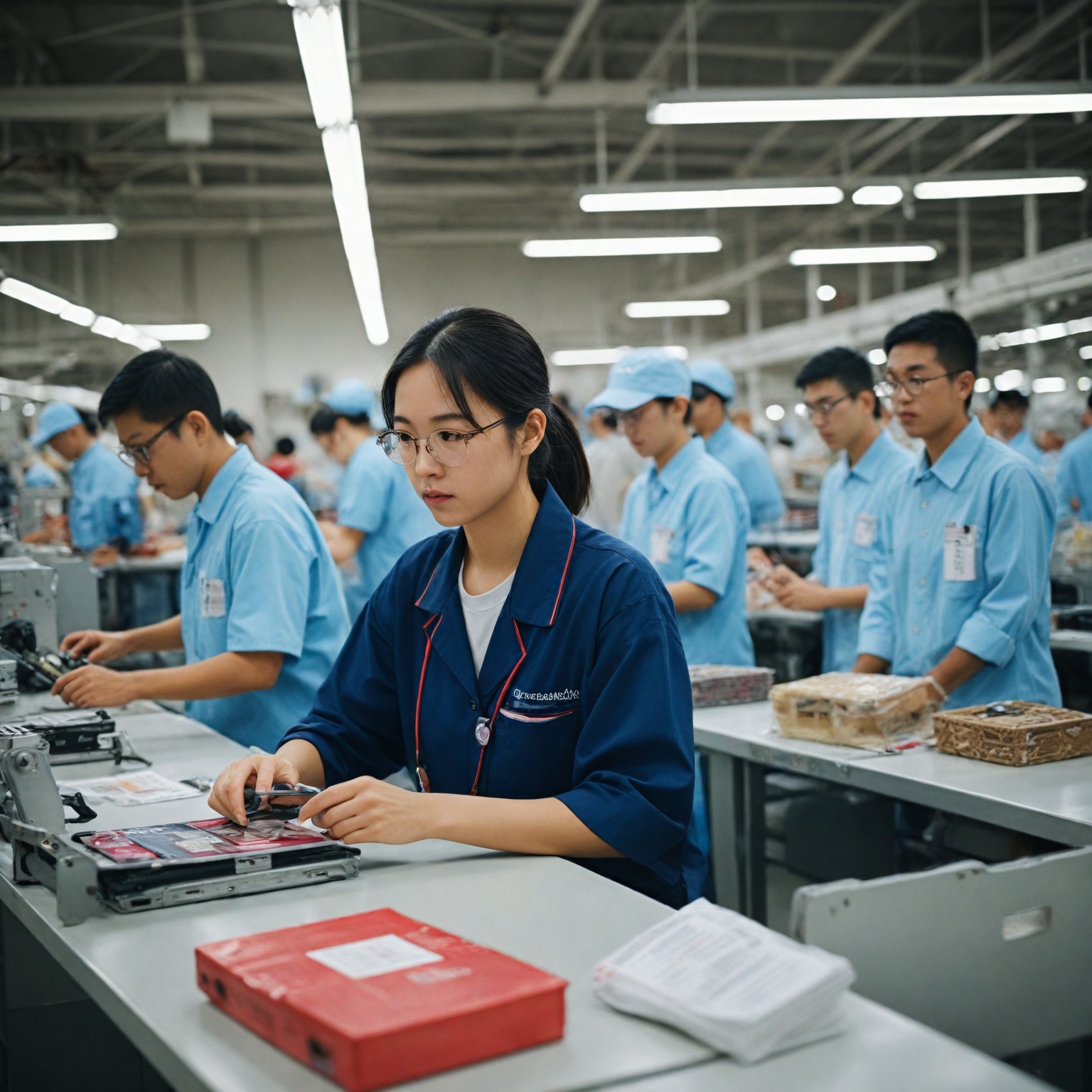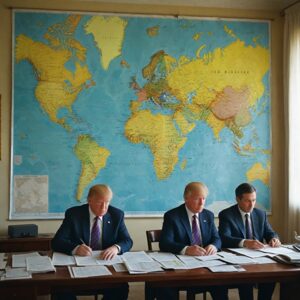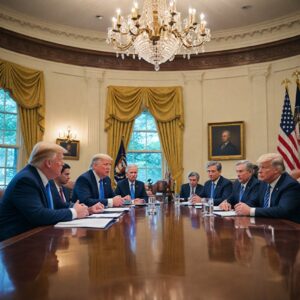Summary
TikTok, a widely-used social media platform known for its short-form video content, has inadvertently become a significant tool for Chinese manufacturers looking to bypass US tariffs. In the face of trade war tensions and increased tariffs imposed by the United States, Chinese businesses have turned to innovative methods such as trade-off manufacturing, tariff exemptions, and product reclassifications to navigate these challenges. A pivotal development has been the rise of TikTok as a platform for direct-to-consumer marketing, revolutionizing supply chain dynamics and offering a new avenue for Chinese manufacturers to sell their products in the US and UK markets.
Chinese manufacturers leverage TikTok’s personalized algorithm to gain visibility for their products, which are presented as affordable, desirable, and easily accessible for American consumers. This strategic use of TikTok is viewed as a calculated effort to circumvent US tariff policies. TikTok’s expansion into e-commerce has further facilitated this bypassing of tariffs, though this comes with its own set of challenges, such as the requirement for a US-based warehouse.
These tactics have significantly impacted global supply chains, with smaller businesses and large brands alike reassessing their strategies. Amid increasing operational costs and tariff-related compliance requirements, innovative solutions such as trade-off manufacturing and agile supply chain models are being adopted. However, the implications of these changes are varied, with concerns about potential cost increases and supply chain disruption.
As TikTok continues to rise in popularity and utility, the platform’s future is marked by uncertainty due to increased political scrutiny. Despite this, it is clear that TikTok has revolutionized how Chinese manufacturers navigate US tariffs, with potential long-term implications for global trade dynamics and supply chain management.
Overview of TikTok
TikTok is a popular social media platform primarily known for its short-form video content. The platform is leveraged for marketing and promoting various brands and their products or services. This innovative approach to marketing, known as TikTok marketing, focuses solely on using TikTok’s platform to engage audiences and showcase business offerings. The goal is to effectively establish a strong online presence through the platform’s unique content format.
In the e-commerce industry, TikTok has proven to be a significant game-changer. For instance, in October 2020, Shopify, a leading e-commerce platform, incorporated TikTok into its array of social media platforms. This move enabled online merchants to sell their products directly to consumers on TikTok. Many small businesses have also adopted TikTok as a marketing tool, enabling them to reach audiences beyond their typical geographical service areas.
Interestingly, there are differences between the US and Chinese versions of TikTok. In an interview with CBS’s “60 Minutes”, a tech expert compared the two versions to opium and spinach, indicating significant variations in the user experiences on the platform.
As of mid-2022, TikTok has shown strong competition against YouTube regarding the amount of time spent per day by their respective US users. Considering their remarkable growth rate in active users, predictions suggest that TikTok could rival leading platforms by early next year. This potential is causing businesses to rethink their supply chain planning, product design, and inventory staging strategies to capitalize on the burgeoning engagement.
US Tariffs on Chinese Manufacturers
The introduction of tariffs by the United States has exerted significant pressure on Chinese manufacturers. These tariffs have compelled businesses to inflate consumer prices, thereby diminishing the competitiveness of these products. Notably, the trade war between the United States and China, initiated in President Trump’s first term, spurred the adoption of the “China Plus One” strategy. This strategy involves manufacturers shifting a portion of their production from China to other Asian countries with reduced labor costs and moderate tariff risks from the U.S.
The United States imposed high tariffs on several countries, including Vietnam. In response, these nations expressed their desire to negotiate with the Trump administration. Vietnam even proposed to eliminate tariffs on U.S. imports immediately. However, U.S. officials remained unsatisfied with this offer, alleging that Vietnam facilitated the redirection of Chinese products destined for the U.S., thereby enabling Chinese manufacturers to evade the higher tariffs targeting Beijing.
Despite the broader trade war, the U.S. announced tariff exemptions on a variety of Chinese products, including electronics, computers, and semiconductors. However, the duration of these exemptions is uncertain. Furthermore, these exemptions do not cover most goods exported by China to the U.S., including apparel and accessories produced by Chinese suppliers.
Chinese manufacturers have adapted to these tariffs by employing innovative strategies. For instance, a U.S. company might manufacture products for a Chinese company to sell in the United States, while the Chinese company manufactures the U.S. company’s products for sale in China or other markets. This reciprocal manufacturing arrangement optimizes costs and navigates tariff barriers. The use of such arrangements saw a marked increase during the COVID-19 pandemic.
Another interesting development has been the use of social media, particularly TikTok, by Chinese manufacturers to reveal the production costs behind high-end consumer goods. Amid the ongoing U.S. tariff increases, these posts have gained significant attention by demonstrating the actual manufacturing costs of items such as Hermès Birkin bags, Lululemon leggings, and laundry capsules. This transparency has caused concern among smaller businesses reliant on Chinese fulfilment over increased operational costs and compliance requirements. Larger brands, such as Nike, which heavily rely on Chinese and Southeast Asian supply chains, are also reassessing their strategies.
TikTok as a Platform for Chinese Manufacturers
An emerging trend noticed on TikTok is the surge of videos from Chinese content creators who encourage Americans to purchase goods directly from Chinese factories. This appears to be a strategic response to navigate around US tariffs, potentially opening new avenues for trade-off manufacturing arrangements.
However, this method has also sparked a wave of discussions among US/UK shop owners who are facing competition due to the lower prices and shorter shipping times offered by Chinese suppliers. Solutions suggested include exploring other suppliers or even changing where materials are obtained or products are assembled. One company, NOBL Wheels, a Canadian manufacturer and supplier of bike wheels, opened a new building operation and distribution center in Bellingham, Washington, to offer faster, hassle-free shipping that’s duty and tariff-free, with significantly shorter lead times.
The global COVID-19 pandemic has also played a significant role in the increase of these arrangements. In conclusion, TikTok has emerged as a significant platform for Chinese manufacturers to leverage for the sale of their products directly to international consumers, potentially influencing global trade dynamics.
Strategies Employed by Chinese Manufacturers
Avoiding Tariffs through Exemptions and Legal Reclassifications
In addition to trade-off manufacturing, companies can also try to avoid or minimize tariffs by requesting exemptions or legally reclassifying their products. In some cases, if a tariff is applied to a specific finished product but not its raw components, a company might consider importing the raw components and then manufacturing the finished product in-country to reduce the tariff load.
Leveraging TikTok to Market Products
On TikTok, brands can create short-form video content to engage with their audience and promote their products or services. Transparency is crucial on the platform. When posting content promoting a brand or product, advertisers must disclose the promotional nature of their content, which helps maintain trust between TikTok users and advertisers.
Bypassing US Tariffs Through TikTok
The advent of TikTok, a popular short video app, has brought a significant shift in the tactics employed by Chinese manufacturers to circumvent US tariffs. This trend has been observed as a calculated effort to undermine US tariff policy towards China. Specifically, Chinese manufacturers use the platform to promote their products as affordable, desirable, and easily accessible to US consumers.
The strategy involves leveraging TikTok’s powerful algorithm to amplify the visibility of Chinese products, and notably, has persisted despite the ambiguity surrounding the legality of tariff avoidance via direct-to-consumer purchasing. For instance, a video showcasing clothes and accessories, which constitute a large portion of goods exported from China to the US, serves to challenge the prevailing narrative that these economic measures serve American interests.
Furthermore, TikTok’s move to grow its e-commerce business in the US has made it easier for Chinese merchants to sell their products directly to American consumers, further facilitating this bypass of US tariffs. There are questions, however, regarding the practicality of using TikTok for this purpose, considering that the platform ostensibly requires a US-based warehouse as a non-negotiable condition.
Notably, this strategy saw a halt when China indicated that it would not approve the spin-off of TikTok’s US assets following President Trump’s tariff announcement, leading to the extension of a deadline for the sale of these assets to a non-Chinese buyer. Despite these setbacks, the phenomenon continues to raise questions about tariff efficacy and its broader impact on American consumers.
Impact on Global Supply Chains
As the global market experiences constant changes in demand, many companies are opting for a spoke-and-wheel supply chain model. These companies are strategically placing regional distribution centers to optimize production and allow for agile inventory movement. This approach aids in resource allocation, especially during periods of heightened demand, thereby ensuring customer satisfaction.
However, certain key supply chain concerns have been identified. These include fluctuating consumer demand, variable raw material prices, and inconsistency in the administrative strategies.
Given the dynamic market scenario, supply chains must remain agile to ensure customer demands are met in times when products cannot stay on shelves long enough to be marketed. Countries, including Vietnam, are attempting to negotiate with the U.S. in hopes of reduced tariffs. However, the outcomes of these negotiations are uncertain, and companies are likely to wait to gauge the results before making any significant moves.
Long-term Implications and Future Predictions
The future of TikTok in the United States is uncertain due to increasing political scrutiny. Yet, TikTok is simultaneously revolutionizing the way Chinese manufacturers bypass U.S tariffs. This transformation is largely due to the novel strategy known informally online as “Trade War TikTok”. This trend involves providing factory tours, cost breakdowns, and direct purchasing advice. Some creators are even suggesting ways to avoid traditional markups and new tariffs by ordering directly from manufacturers through platforms like Taobao or via direct messaging on WeChat and WhatsApp.
This new reality of direct consumer access to manufacturers is potentially threatening the traditional supply chains. However, it also poses an opportunity for companies to restructure their supply chain to become more resilient and capable of anticipating changes in demand before they occur. This reimagined structure would enable companies to optimize their resources in the face of ‘viral moments’, ensuring the fulfillment of demand and customer satisfaction.
The changes in supply chains, however, could lead to cost increases, with some companies suggesting that reshoring their supply chains could double their costs. As for products still being shipped from China, it’s challenging to predict how much their prices will increase for U.S. consumers. Tariffs have risen significantly in the recent past, and it takes considerable time for products to be shipped from China’s ports to U.S. supermarket shelves.
Moreover, TikTok is set to launch live shopping in the U.S, a development that could further alter the supply chain dynamics and the way Chinese manufacturers sell their products. The implications of this development could be far-reaching, depending on how well supply chains can adapt and engage with this new reality.

























